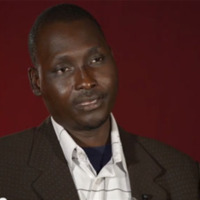
William
In 1985 William Akoi Mawwin was captured and forced into slavery at the age of six years. During raids by Muslim militia from Northern Sudan on the villages of the Christian Dinka tribes during the 1980s, tens of thousands of other boys between the ages of four and ten had the same fate. As well, babies and toddlers were killed, and girls were raped, killed, or forced into slavery. Some boys who escaped capture headed to refugee camps in Kenya, but it is estimated that only one in three survived the journey.After seven years in slavery, William escaped and lived on the streets of the capital. He worked to earn money for a passport, and left for Cairo, Egypt, where he found work in a rubber factory before a machinery accident took his hands. In 2001 the US government granted 3600 Sudanese orphans refugee status. Some 500 boys, including 21-year-old William, were placed in Arizona.William fashions his capture as a sudden disappearance: “You’re gone for good.” But his narrative confronts this problem of erasure and offers a solution: “I’m here,” he insists. This assertion of ongoing presence is part of William’s call to action. While his family gave him up as dead after he disappeared—“[n]obody believed,” he observes—William refuses to give up, in turn, on other slave children: “I’m not going to give up. I believe,” he concludes. For while he still doesn’t feel entirely liberated (explaining that his “heart’s not free”), William seeks a final sense of freedom through activism that might lead to a large-scale liberation of Sudan’s slaves. Reminding his reader about “the kids who are slaves today,” he asks: “What are we going to do…?”